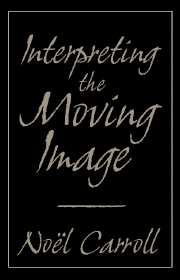Book contents
- Frontmatter
- Contents
- Foreword: Through Carroll's Looking Glass of Criticism
- Introduction
- 1 The Cabinet of Dr. Kracauer
- 2 Entr'acte, Paris and Dada
- 3 The Gold Rush
- 4 Keaton: Film Acting as Action
- 5 Buster Keaton, The General, and Visible Intelligibility
- 6 For God and Country
- 7 Lang, Pabst, and Sound
- 8 Notes on Dreyer's Vampyr
- 9 King Kong: Ape and Essence
- 10 Becky Sharp Takes Over
- 11 Interpreting Citizen Kane
- 12 The Moral Ecology of Melodrama: The Family Plot and Magnificent Obsession
- 13 Mind, Medium, and Metaphor in Harry Smith's Heaven and Earth Magic
- 14 Welles and Kafka
- 15 Nothing But a Man and The Cool World
- 16 Identity and Difference: From Ritual Symbolism to Condensation in Anger's Inauguration of the Pleasure Dome
- 17 Text of Light
- 18 Joan Jonas: Making the Image Visible
- 19 Introduction to Journeys from Berlin/1971
- 20 The Future of Allusion: Hollywood in the Seventies (and Beyond)
- 21 Back to Basics
- 22 Amy Taubin's Bag
- 23 Herzog, Presence, and Paradox
- 24 Film in the Age of Postmodernism
- Notes
- Index
7 - Lang, Pabst, and Sound
Published online by Cambridge University Press: 05 June 2012
- Frontmatter
- Contents
- Foreword: Through Carroll's Looking Glass of Criticism
- Introduction
- 1 The Cabinet of Dr. Kracauer
- 2 Entr'acte, Paris and Dada
- 3 The Gold Rush
- 4 Keaton: Film Acting as Action
- 5 Buster Keaton, The General, and Visible Intelligibility
- 6 For God and Country
- 7 Lang, Pabst, and Sound
- 8 Notes on Dreyer's Vampyr
- 9 King Kong: Ape and Essence
- 10 Becky Sharp Takes Over
- 11 Interpreting Citizen Kane
- 12 The Moral Ecology of Melodrama: The Family Plot and Magnificent Obsession
- 13 Mind, Medium, and Metaphor in Harry Smith's Heaven and Earth Magic
- 14 Welles and Kafka
- 15 Nothing But a Man and The Cool World
- 16 Identity and Difference: From Ritual Symbolism to Condensation in Anger's Inauguration of the Pleasure Dome
- 17 Text of Light
- 18 Joan Jonas: Making the Image Visible
- 19 Introduction to Journeys from Berlin/1971
- 20 The Future of Allusion: Hollywood in the Seventies (and Beyond)
- 21 Back to Basics
- 22 Amy Taubin's Bag
- 23 Herzog, Presence, and Paradox
- 24 Film in the Age of Postmodernism
- Notes
- Index
Summary
The coming of sound caused a crisis in film aesthetics. Some theoreticians, notably Arnheim, refused to endorse the shift at all. Sound, for them, was a return to canned theater, a regression to the pre-Griffith era before film had weaned itself from the stage.
More adventurous thinkers, however, embraced the new device and attempted to incorporate it into the aesthetic system of silent film. Eisenstein, Pudovkin, and Alexandrov, in their famous 1928 statement on sound, and Roman Jakobson, in a rarely discussed 1933 article entitled “Is the Cinema in Decline?” proposed that sound be understood as a montage element: aural units should be juxtaposed against the visuals, just as shots should be juxtaposed against shots. Jakobson, ironically, answers someone like Arnheim in the same manner that Arnheim would have answered someone like Clive Bell. Jakobson tells the opponent of sound that his opposition is not based on a thoughtful look at the possibilities of the new medium. Jakobson argues that the sound element in a scene can be asynchronous and contrapuntal, thereby diverging from mere reproduction. This possibility enriches cinema, for added to all the conceivable visual juxtapositions of the silent film are inestimably large reservoirs of sound counterpoints.
The Eisenstein – Jakobson reaction to sound was conservative in one sense. It was an attempt to extrapolate the basic concepts of a silent film aesthetic to a new development, recommending montage as the basic paradigm for dealing with sound.
- Type
- Chapter
- Information
- Interpreting the Moving Image , pp. 92 - 104Publisher: Cambridge University PressPrint publication year: 1998



